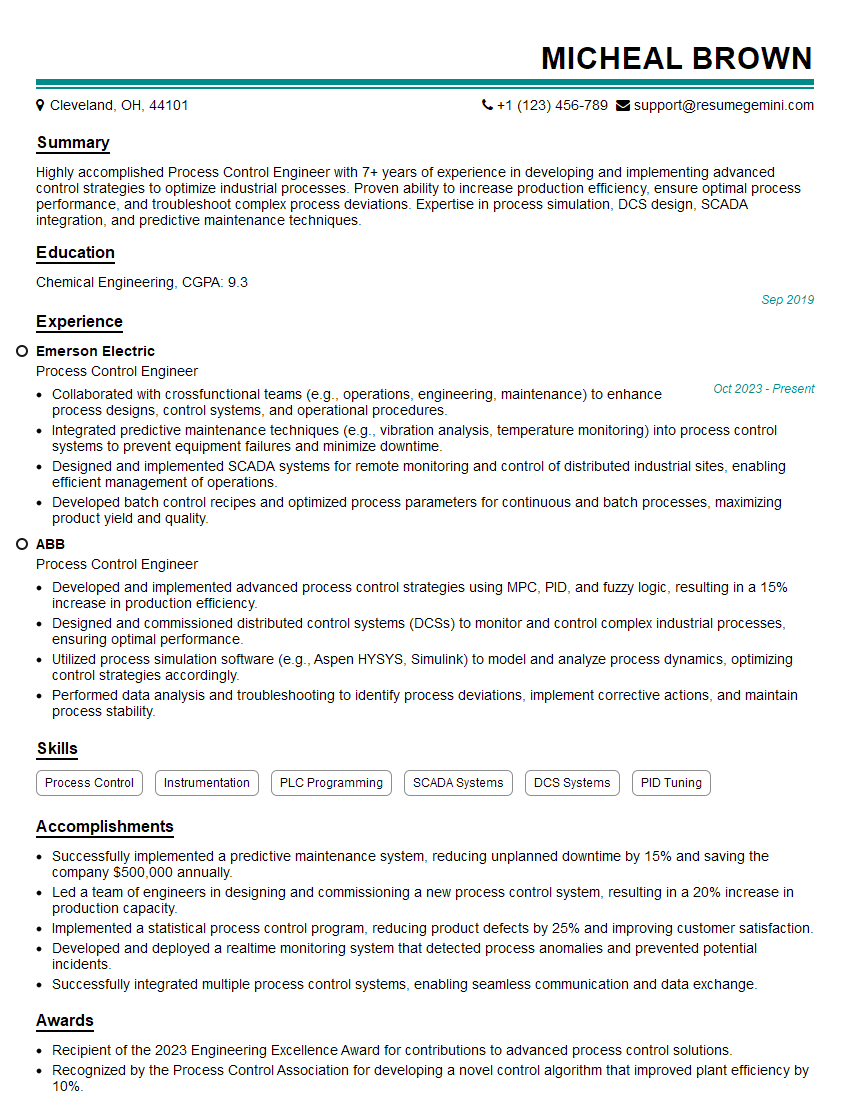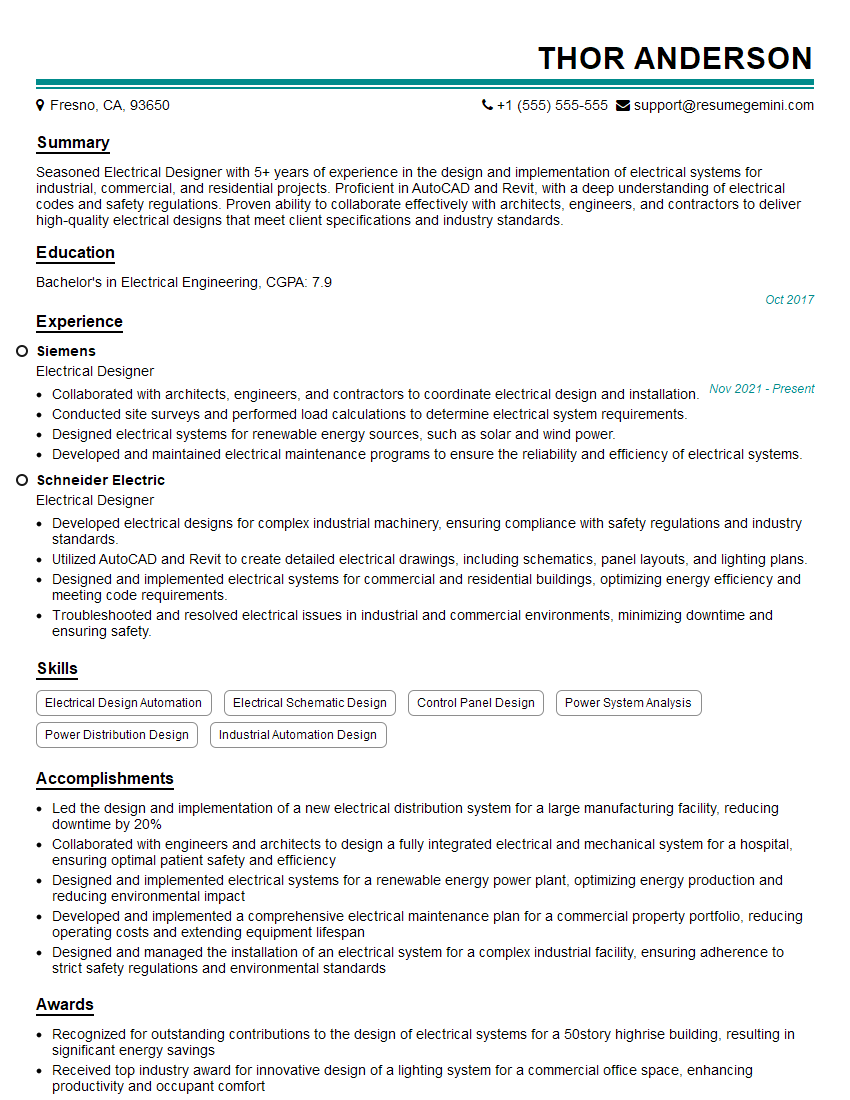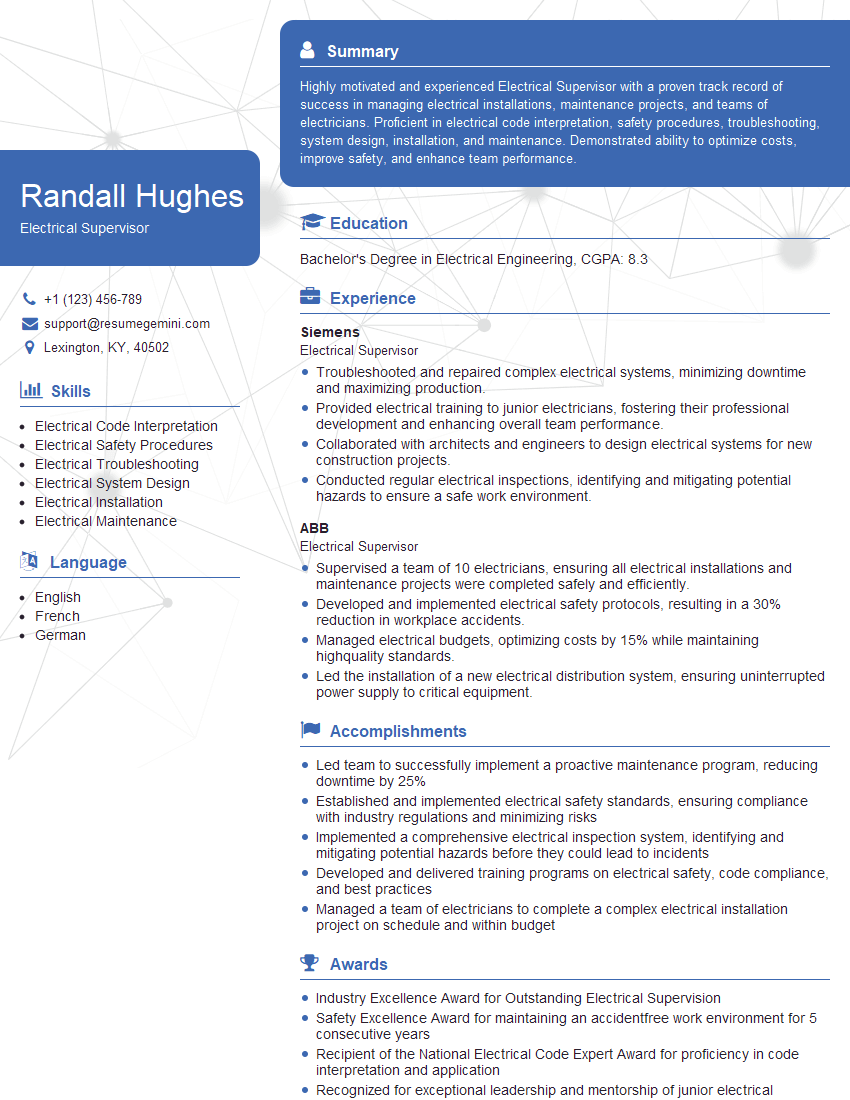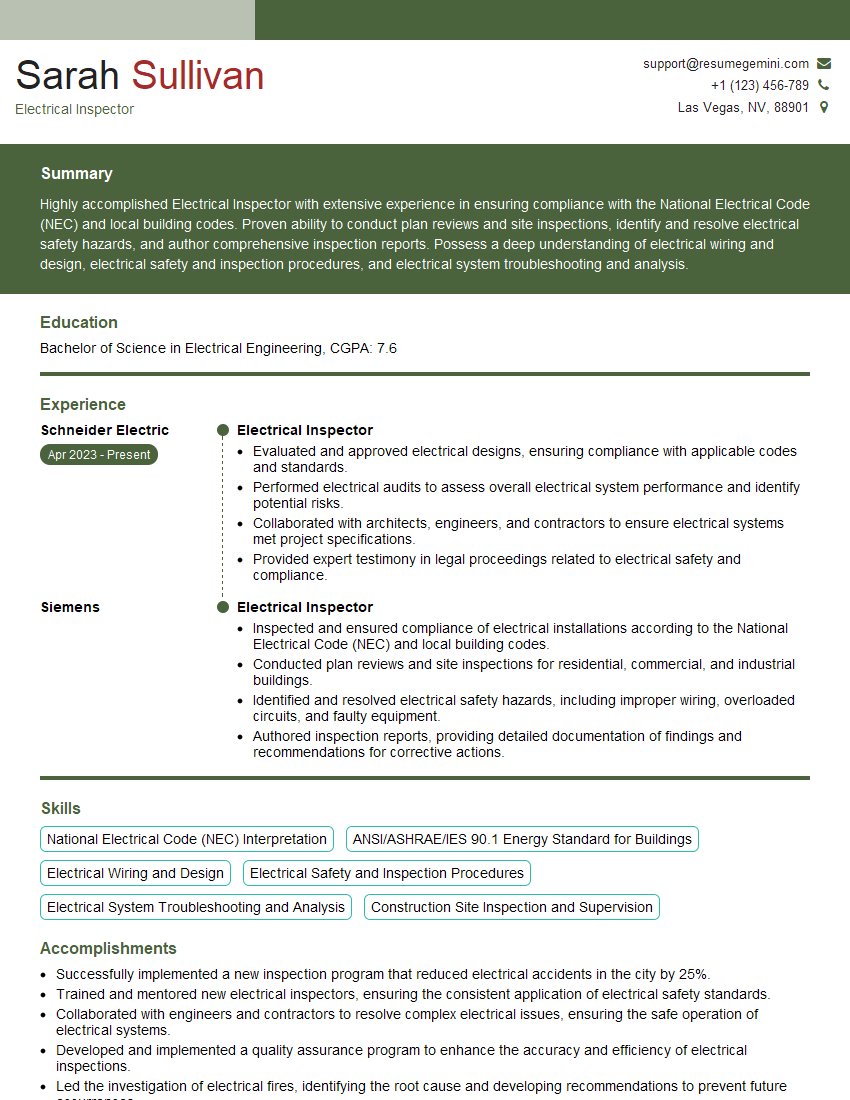Every successful interview starts with knowing what to expect. In this blog, we’ll take you through the top Electrical Bonding and Grounding interview questions, breaking them down with expert tips to help you deliver impactful answers. Step into your next interview fully prepared and ready to succeed.
Questions Asked in Electrical Bonding and Grounding Interview
Q 1. Explain the purpose of electrical bonding.
Electrical bonding is the process of connecting two or more metal components electrically to ensure they are at the same potential. Think of it like creating a network of interconnected pipes, all at the same water level. This prevents dangerous voltage differences between these components, minimizing the risk of electric shock and reducing the likelihood of damaging electrical surges.
The primary purpose is safety. By ensuring all metallic parts are at the same potential, bonding eliminates the possibility of a dangerous voltage potential difference between them. For instance, in a building, bonding metal pipes, conduit, and enclosures prevents a shock hazard if a fault occurs in the electrical system.
Another important function is to provide a low impedance path for fault currents to flow, thereby assisting the operation of protective devices like circuit breakers or ground fault circuit interrupters (GFCIs). This quick path ensures the fault is cleared rapidly, minimizing damage and preventing fires.
Q 2. Describe the difference between bonding and grounding.
While both bonding and grounding involve connecting metallic components electrically, they serve distinct purposes. Bonding connects non-current-carrying metallic parts within an electrical system to each other, ensuring they are at the same potential. Grounding, on the other hand, connects the system to the earth, providing a safe path for fault currents to dissipate into the ground.
Imagine a building’s electrical system. Bonding connects all metal conduit, enclosures, and equipment casings to each other, eliminating voltage differences between these parts. Grounding connects the electrical system’s neutral point to a grounding electrode (like a ground rod driven into the earth), providing a safe path for fault current to flow to the earth.
In essence, bonding is like connecting the metal parts of a ship to each other to prevent electrical differences; grounding is like connecting the ship’s hull to the ocean to provide a safe path for any electrical leakage.
Q 3. What are the common methods of electrical grounding?
Several methods exist for electrical grounding, each with its own advantages and applications:
- Ground Rod: A metal rod driven into the earth. This is a common and effective method, particularly in residential settings.
- Ground Plate: A large, conductive plate buried in the earth, providing a larger surface area for current dissipation.
- Water Pipe Grounding: Connecting the grounding electrode to a metallic water pipe. This method is becoming less common due to the increasing use of plastic pipes.
- Concrete-Encased Electrode: A conductive electrode embedded in a concrete foundation. This offers a durable and effective grounding system.
- Building Steel Structure: Utilizing the building’s steel framework as part of the grounding system.
The choice of method depends on factors such as soil conductivity, the size and type of structure, and local electrical codes.
Q 4. Explain the concept of equipotential bonding.
Equipotential bonding aims to create a single equipotential plane – a surface where all points have the same electrical potential. This is achieved by bonding all conductive components in an area, effectively eliminating potential differences that could lead to dangerous touch voltages.
Consider a bathroom. Equipotential bonding connects the metal parts of the plumbing system, electrical fixtures, and even the metal bathtub to create a single equipotential zone. If a fault occurs in an appliance, the bonding ensures that no dangerous voltage exists between these metallic parts. Someone touching multiple parts simultaneously would not receive a shock, as they’re all at the same voltage.
This is crucial in areas where the risk of electric shock is high, such as bathrooms, swimming pools, and industrial environments.
Q 5. What are the safety implications of inadequate grounding?
Inadequate grounding poses several severe safety implications:
- Electric Shock: A lack of a proper grounding path can result in dangerous voltages appearing on exposed metal parts, leading to potentially fatal electric shocks. Imagine touching a faulty appliance with inadequate grounding; the current might flow through your body to the ground, causing serious harm.
- Equipment Damage: Grounding protects equipment from voltage surges and electrical noise. Without adequate grounding, sensitive equipment is vulnerable to damage and premature failure.
- Fire Hazards: A grounding fault can lead to overheating in wiring and equipment, increasing the risk of electrical fires. A proper ground path provides a low-impedance path for fault currents to flow, quickly tripping protective devices and minimizing fire risks.
- Data Loss: In computer systems, inadequate grounding can lead to data loss and equipment malfunction due to electrical noise and interference.
In short, inadequate grounding can have dire consequences, ranging from minor equipment damage to severe injury or death.
Q 6. How do you identify grounding faults?
Grounding faults are identified through various methods:
- Visual Inspection: Checking for loose connections, damaged wires, or corrosion in the grounding system.
- Ground Resistance Testing: Using a ground resistance tester to measure the resistance between the grounding electrode and the earth. A high resistance indicates a grounding fault.
- Loop Impedance Testing: This measures the total impedance of the earth loop path, allowing for the identification of high-impedance points within the system.
- Ground Fault Circuit Interrupters (GFCIs): These protective devices detect ground faults and automatically disconnect the circuit, preventing electric shocks. A constantly tripping GFCI is a sign of a grounding fault.
Regular inspections and testing are crucial for identifying and mitigating grounding faults before they become hazardous.
Q 7. Describe the role of a grounding electrode.
A grounding electrode’s primary role is to provide a low-resistance path for fault currents to flow to the earth, safely dissipating the energy and protecting personnel and equipment.
It acts as a direct connection between the electrical system and the earth, ensuring that in the event of a fault (like a short circuit), the fault current is quickly diverted to the ground, preventing the buildup of dangerous voltages on conductive surfaces.
The effectiveness of the grounding electrode is dependent on factors such as the type of electrode used (rod, plate, etc.), its physical dimensions, the soil conductivity, and the proper installation techniques. A poorly installed or inadequate grounding electrode can severely compromise the safety of an electrical system.
Q 8. Explain the importance of ground resistance testing.
Ground resistance testing is crucial for ensuring the safety and effectiveness of your grounding system. Low ground resistance is essential because it provides a low-impedance path for fault currents to flow to the earth, preventing dangerous voltage buildup on equipment and protecting people from electric shock. Think of it like this: the lower the resistance, the easier it is for electricity to ‘escape’ to the ground in case of a fault. High resistance means the electricity might find alternative, more dangerous paths.
Testing involves measuring the resistance between the grounding electrode and the earth using a specialized instrument called a ground resistance tester. The acceptable value depends on several factors including the type of installation and local codes. A high resistance reading indicates a problem that needs to be addressed, such as corrosion on the grounding electrode, poor soil conditions, or inadequate connection.
For example, imagine a poorly grounded electrical panel in a house. If a fault occurs, high ground resistance could lead to dangerous voltage levels on the panel’s metal enclosure, posing a shock hazard. Regular testing ensures that such scenarios are identified and rectified before they lead to accidents.
Q 9. What are the standards and codes related to electrical bonding and grounding (e.g., NEC, IEC)?
Several standards and codes govern electrical bonding and grounding, ensuring safety and consistency across installations. The most prominent are:
- National Electrical Code (NEC): In the United States, the NEC provides detailed requirements for grounding and bonding in electrical systems. It specifies conductor sizes, grounding electrode requirements, and bonding techniques for various applications.
- International Electrotechnical Commission (IEC) Standards: IEC standards offer a global perspective on grounding and bonding, offering guidance and recommendations adopted internationally. Specific standards like IEC 60364 address low-voltage electrical installations and provide comprehensive information about grounding.
- Other Regional Standards: Many countries have their own national standards that may incorporate or adapt elements from the NEC and IEC standards, reflecting local conditions and practices.
Understanding these codes is paramount for any electrician or engineer working in the field. Compliance is crucial for safety and avoiding legal issues. Each installation will have specific requirements based on the application, building type, and local jurisdiction.
Q 10. How do you select appropriate grounding conductors?
Selecting appropriate grounding conductors involves considering several factors to ensure sufficient current-carrying capacity and low impedance.
- Fault Current Magnitude: The anticipated fault current is the primary driver. Larger fault currents require larger conductors to handle the heat generated.
- Conductor Material: Copper and aluminum are commonly used. Copper offers better conductivity but is more expensive. Aluminum is lighter and cheaper but requires more careful handling due to its tendency to oxidize.
- Conductor Size: The NEC and IEC standards provide tables that specify minimum conductor sizes based on fault current and installation type. These tables take into account factors like temperature rise and voltage drop.
- Installation Method: The way the conductor is installed (buried, in conduit, etc.) affects its heat dissipation capabilities, influencing the choice of conductor size. Buried conductors generally require larger sizes due to reduced cooling.
- Length of the Conductor: Longer conductors result in higher resistance, necessitating larger sizes to compensate for voltage drop.
For instance, grounding a large industrial facility would require much larger conductors than grounding a small residential building because the anticipated fault currents are significantly higher. Incorrect selection could lead to overheating, potential fires, or inadequate protection.
Q 11. Explain the concept of earth fault current.
Earth fault current refers to the current that flows to the earth through a grounding system when a fault occurs. This fault can be a short circuit between a live conductor and the earth, or any exposed conductive part of the equipment that is connected to earth. The magnitude of this current is influenced by several factors including the system voltage, impedance of the grounding path, and the characteristics of the fault itself. It is a critical consideration in safety design as this current flow is what activates protective devices like circuit breakers and ground fault circuit interrupters (GFCIs).
Imagine a scenario where a faulty appliance has a live wire touching its metal casing. If the appliance is correctly grounded, a substantial earth fault current will flow. This current will trip a circuit breaker or GFCI, quickly disconnecting the appliance and preventing electrocution. Without a low-resistance grounding path, the fault current might be insufficient to trip the protective device, posing a significant danger.
Q 12. Describe different types of grounding systems (e.g., TN-S, TT, IT).
Grounding systems are categorized based on how the neutral point of the power supply is connected to earth. Common systems include:
- TN-S: This system has a separate neutral conductor (N) and protective earth conductor (PE), both connected to earth at the supply point. This offers excellent protection.
- TT: In this system, the neutral point of the power supply is earthed at the source, but the exposed conductive parts of the equipment are earthed separately and locally. This configuration provides a high degree of fault current independence.
- IT: The neutral point of the power supply is not directly earthed, instead it’s insulated or connected to earth through a high impedance path. This system offers better fault tolerance as a single fault will not immediately cause a trip. However, additional monitoring is required to detect such faults.
The choice of grounding system depends on factors like the size of the installation, risk assessment, and local regulations. Each system has different advantages and disadvantages regarding safety, cost, and fault tolerance. For example, TN-S is very common in residential settings for its simplicity and good safety performance. IT systems are more typical in sensitive facilities like hospitals where uninterrupted power is crucial.
Q 13. How do you assess the effectiveness of a grounding system?
Assessing the effectiveness of a grounding system involves a multi-pronged approach. Regular testing and inspections are crucial.
- Ground Resistance Testing: Measuring the resistance of the grounding electrode to earth, as discussed earlier, is fundamental. Results should be within acceptable limits defined by relevant standards.
- Earth Potential Rise Measurement: This test measures the voltage rise that occurs at the grounding electrode during a fault. A high voltage rise indicates a less effective ground.
- Loop Impedance Testing: This test determines the impedance of the fault loop – the path the fault current takes back to the source. Low loop impedance ensures rapid fault clearing by protective devices.
- Visual Inspections: Regular visual inspection of grounding conductors, electrodes, and connections helps identify corrosion, damage, or loose connections. Proper maintenance plays a significant role.
By combining these methods, you gain a comprehensive understanding of your grounding system’s effectiveness. Any deviations from acceptable values require immediate attention and corrective actions. For instance, a high ground resistance might require replacement or augmentation of grounding electrodes, while loose connections need to be tightened immediately to avoid safety hazards.
Q 14. Explain the use of ground fault circuit interrupters (GFCIs).
Ground Fault Circuit Interrupters (GFCIs) are safety devices designed to protect against electric shocks. They work by continuously monitoring the current flowing in the hot and neutral conductors of a circuit. If there is an imbalance – indicating current leakage to ground – the GFCI quickly trips, interrupting the power supply. This rapid response minimizes the risk of electric shock, which is especially crucial in areas with high moisture or near water sources.
The sensitivity of a GFCI is measured in milliamperes (mA). Typically, GFCIs for household use trip at 5 mA or less. This means even a small leakage current will trigger the device. Imagine a scenario where someone accidentally touches a live wire, with a small current leaking to ground through their body. A GFCI will quickly sense this imbalance and interrupt the power, preventing serious injury or even fatality. GFCIs are commonly found in bathrooms, kitchens, and outdoor outlets – areas where the risk of electric shock is higher.
Q 15. What are the challenges associated with grounding in high-voltage systems?
Grounding high-voltage systems presents unique challenges due to the significantly higher potential for electrical surges and fault currents. The sheer magnitude of energy involved necessitates robust grounding systems capable of safely dissipating these currents without causing damage or posing a safety hazard.
- High Fault Currents: High-voltage faults generate incredibly high currents, requiring low-impedance grounding paths capable of handling these massive flows. A poorly designed system can lead to ground potential rise, creating dangerous voltage gradients and posing a severe shock hazard to personnel.
- Surge Protection: Lightning strikes and switching surges can induce dangerously high transient voltages. Specialized surge protection devices (SPDs) are crucial to shunt these surges to ground, preventing equipment damage.
- Grounding Electrode Design: Designing effective grounding electrodes for high-voltage systems is complex. Factors like soil resistivity, electrode configuration, and the number of electrodes need careful consideration to achieve the required low impedance. Extensive soil testing is usually required.
- Coordination with Protection Systems: The grounding system must be carefully coordinated with the protection relays and circuit breakers. The protection system needs to reliably detect and clear faults before excessive damage occurs, and the grounding system needs to support the safe dissipation of the fault current.
- Safety Compliance: Stringent safety standards and regulations govern high-voltage grounding, demanding meticulous design, installation, and testing to meet safety requirements and ensure personnel safety.
For example, consider a substation grounding system. It needs to handle fault currents in the tens or hundreds of kiloamperes, requiring a complex network of grounding electrodes, conductors, and surge arresters. Inadequate grounding in this scenario could lead to equipment failure, fires, and serious injury.
Career Expert Tips:
- Ace those interviews! Prepare effectively by reviewing the Top 50 Most Common Interview Questions on ResumeGemini.
- Navigate your job search with confidence! Explore a wide range of Career Tips on ResumeGemini. Learn about common challenges and recommendations to overcome them.
- Craft the perfect resume! Master the Art of Resume Writing with ResumeGemini’s guide. Showcase your unique qualifications and achievements effectively.
- Don’t miss out on holiday savings! Build your dream resume with ResumeGemini’s ATS optimized templates.
Q 16. Describe the bonding requirements for metallic piping systems.
Metallic piping systems, especially those carrying flammable or hazardous materials, require careful bonding to ensure electrical continuity and prevent the buildup of static electricity or stray currents. The goal is to create a equipotential plane, minimizing voltage differences that could lead to sparking or corrosion.
- Continuous Bonding: All metallic piping sections should be electrically bonded together using appropriate conductors (e.g., copper or copper-clad steel) to eliminate potential differences. This includes joints, valves, and fittings.
- Bonding to the Grounding System: The piping system needs to be bonded to the main grounding electrode system of the facility. This typically involves connecting the piping to a grounding rod or grid.
- Conductor Sizing: The bonding conductors must be sized appropriately to handle anticipated fault currents. Larger pipes or higher risk applications may require larger conductors.
- Corrosion Protection: Bonding conductors should be protected against corrosion to maintain conductivity over the system’s lifespan. This may involve using corrosion-resistant materials or applying protective coatings.
- Inspection and Maintenance: Regular inspection and maintenance are critical to ensure the integrity of the bonding system. Corrosion, damage, or loose connections can compromise the effectiveness of the system.
Imagine a chemical plant with numerous metallic pipes carrying flammable liquids. A break in the bonding could lead to the accumulation of static electricity, which could trigger a spark and ignite the flammable material. Proper bonding is essential for safety and preventing catastrophic events.
Q 17. How do you handle grounding in hazardous locations?
Grounding in hazardous locations requires special consideration due to the increased risk of ignition of flammable materials or explosion. The goal is to minimize the potential for sparks and electrical arcing, which could ignite the hazardous atmosphere.
- Intrinsically Safe Equipment: In Class I, Division 1 (hazardous) locations, intrinsically safe equipment is often used. This equipment is designed to limit the energy levels to prevent ignition.
- Explosion-Proof Enclosures: Equipment is often housed in explosion-proof enclosures to contain any internal sparks or arcs.
- Specialized Grounding Methods: The grounding system may incorporate features like grounding grids designed to minimize voltage gradients and prevent stray currents. Grounding conductors may also be specially selected to withstand the harsh environment.
- Equipment Bonding: Similar to piping systems, bonding of metallic equipment and enclosures is critical to prevent potential differences that could lead to arcing.
- Regular Inspection and Testing: Rigorous inspection and testing are essential to ensure the grounding system remains effective and compliant with safety regulations.
For example, an oil refinery requires a very robust grounding system to protect against the risk of explosions. Every piece of equipment and piping will be carefully bonded and grounded, and the system will be subject to regular inspections and testing to maintain safety.
Q 18. Explain the impact of soil resistivity on grounding design.
Soil resistivity is a critical factor influencing grounding design. It represents the soil’s resistance to the flow of electrical current. Higher soil resistivity means that the earth will offer more resistance to the dissipation of fault currents, requiring a more extensive and carefully designed grounding system.
- Electrode Design: In high-resistivity soil, larger grounding electrodes or multiple electrodes may be necessary to achieve the required low impedance. Techniques like chemical soil treatment may be considered to lower resistivity.
- Grounding Grids: Extensive grounding grids are often used in high-resistivity soils to provide a larger surface area for current dissipation.
- Grounding Rod Placement: The placement of grounding rods must be carefully chosen to avoid areas with exceptionally high resistivity.
- Ground Resistance Testing: Thorough ground resistance testing is crucial to verify that the designed impedance is achieved. This is typically done with a ground resistance tester.
- Impact on Safety: High soil resistivity can lead to increased ground potential rise during a fault, increasing the risk of electrical shock.
Consider a scenario where a substation is built on rocky terrain with high soil resistivity. A simple grounding rod may be insufficient. A large grounding grid, possibly supplemented by chemical treatment of the soil around the electrodes, would be necessary to ensure adequate grounding.
Q 19. What are the common causes of grounding problems?
Grounding problems can stem from various causes, impacting safety and equipment performance. Identifying these issues is crucial for maintaining a reliable and safe electrical system.
- Corrosion: Corrosion of grounding electrodes or conductors increases resistance, reducing the effectiveness of the grounding system. This is particularly problematic in harsh environments.
- Loose Connections: Loose connections at grounding points create high-resistance pathways, hindering effective current flow.
- Improper Grounding Electrode Design: Inadequate size or poor placement of grounding electrodes may not provide sufficient current dissipation capacity.
- High Soil Resistivity: As discussed earlier, high soil resistivity makes effective grounding more challenging.
- Damage to Grounding Conductors: Physical damage to grounding conductors, such as from excavation or rodent activity, can interrupt the grounding path.
- Insufficient Grounding Conductor Size: Undersized grounding conductors can overheat and fail during a fault.
For example, a corroded grounding electrode might not provide a reliable path to earth, leading to increased ground potential rise during a fault. Similarly, a loose connection at a grounding terminal could create a high-resistance point, disrupting the overall system effectiveness.
Q 20. How do you troubleshoot grounding issues?
Troubleshooting grounding issues requires a systematic approach involving testing, inspection, and analysis. This often involves specialized equipment and knowledge.
- Ground Resistance Testing: Measuring the ground resistance using a ground resistance tester is the first step to assess the effectiveness of the grounding system. Results should be compared to acceptable values defined by relevant standards and codes.
- Visual Inspection: A thorough visual inspection of all grounding conductors, electrodes, and connections is crucial to identify any signs of corrosion, damage, or loose connections.
- Continuity Testing: Continuity testing verifies the complete electrical path from equipment to ground. A break in the path indicates a problem.
- Voltage Gradient Measurements: Measuring voltage gradients around grounding electrodes helps to identify areas with high resistance or potential differences.
- Soil Resistivity Testing: Testing soil resistivity helps determine whether soil conditions are contributing to grounding problems.
If a ground resistance test reveals high resistance, a visual inspection might pinpoint a corroded electrode or loose connection. Addressing these issues, such as replacing the corroded electrode or tightening the connection, will restore the grounding system’s effectiveness.
Q 21. Explain the concept of transient voltage surge suppression.
Transient voltage surge suppression aims to protect sensitive electrical equipment from damage caused by transient overvoltages. These surges, often caused by lightning strikes or switching operations, can exceed the equipment’s voltage rating, leading to malfunctions or failures. Suppression utilizes devices that divert or absorb the surge energy.
- Surge Protection Devices (SPDs): SPDs, such as metal-oxide varistors (MOVs) and gas discharge tubes (GDTs), are designed to clamp or shunt excess voltage to ground, protecting connected equipment. They are typically connected between the power lines and ground.
- Surge Arresters: Surge arresters are a specific type of SPD designed for higher voltage applications, like substations and transmission lines.
- Coordination of SPDs: SPDs need to be properly coordinated to ensure that the closest SPD to the equipment absorbs the surge before it reaches the equipment.
- Protection Levels: SPDs have specific protection levels indicating the maximum voltage they can safely handle. Selecting the appropriate protection level is crucial for effective protection.
- Maintenance and Replacement: SPDs degrade over time and may need periodic testing and replacement to maintain their effectiveness.
Imagine a computer server room. A lightning strike nearby could induce a high-voltage surge on the power lines. Without SPDs, this surge could damage the servers. SPDs placed strategically in the power distribution system will divert the surge to ground, protecting the sensitive equipment.
Q 22. Describe the use of grounding lugs and clamps.
Grounding lugs and clamps are crucial components in electrical bonding and grounding systems. Their primary function is to provide a secure and reliable connection between various conductive parts, ensuring a low-impedance path for fault currents to flow to the earth. Lugs are typically bolted or crimped onto conductors, while clamps offer a more flexible solution, often used to connect grounding wires to pipes or other metallic structures.
Lugs are used for permanent connections, offering a robust and reliable connection. Think of them as the anchors of your grounding system. They come in various sizes and configurations depending on the wire gauge and the application. For example, a large copper lug might be used to connect the grounding electrode conductor to the grounding electrode itself.
Clamps, on the other hand, are advantageous for temporary or easily removable connections. They allow for flexibility and easy inspection or maintenance. Imagine using a clamp to temporarily connect a grounding wire to a piece of equipment during testing or installation. Their design ensures that the connection maintains a good electrical contact, even under vibrations or temperature changes.
Properly sized and installed lugs and clamps are essential for ensuring the integrity and safety of the electrical system. A loose or improperly installed lug or clamp can lead to increased resistance in the grounding path, potentially leading to hazardous situations.
Q 23. How do you ensure proper bonding during construction?
Ensuring proper bonding during construction requires a meticulous approach, beginning with careful planning and continuing throughout the entire process. It’s like building a sturdy bridge—every component must be securely connected for the entire structure to withstand stress.
- Pre-construction planning: The first step is to review the electrical drawings and specifications to understand the bonding requirements. Identify all conductive components that need to be bonded, including metallic pipes, conduits, and equipment enclosures.
- Material selection: Choose appropriate bonding conductors (usually copper) of the correct size to handle the anticipated fault currents. Remember, bigger is usually better when it comes to safety margins.
- Installation practices: All bonding connections must be made using approved methods, such as welding, brazing, or using properly installed lugs and clamps. Connections must be mechanically sound and corrosion-resistant. Regularly inspect these connections during and after the project to confirm proper contact and address any corrosion issues.
- Testing and inspection: Thorough testing using a low-impedance ground tester is crucial to verify the effectiveness of the bonding system. The test results should be documented and kept on file.
A real-world example: During the construction of a new hospital, we meticulously bonded all the metallic water pipes, gas lines, and electrical conduits to the main grounding electrode system. This ensured that even if a fault occurred in any of these systems, the resulting fault current would safely pass to the ground, minimizing the risk of electrical shock or fire.
Q 24. What are the maintenance requirements for grounding systems?
Maintenance of grounding systems is paramount for ongoing safety and reliability. Neglect can lead to compromised grounding, which is a significant safety hazard. Regular inspections and testing are essential. Imagine it as maintaining the foundation of a building; you don’t want cracks or weaknesses to go unnoticed.
- Visual inspections: Regularly inspect all grounding conductors, electrodes, and connections for signs of corrosion, damage, or loose connections. Look for anything out of the ordinary.
- Ground resistance testing: Ground resistance should be measured annually, or more frequently if there’s a higher risk. Testing helps identify any increase in ground impedance which can indicate a problem. Test results should be documented.
- Connection tightness: Check the tightness of all bolted connections. A loose connection can quickly lead to corrosion and increased resistance.
- Corrosion protection: Apply appropriate corrosion protection measures, such as painting or using anti-corrosion coatings, where necessary. This is particularly important in harsh environments.
For instance, at a manufacturing facility, we implemented a scheduled grounding system inspection program, including annual ground resistance testing. This proactive approach enabled us to promptly identify and rectify a corroded ground connection before it posed a safety risk.
Q 25. Explain the role of bonding in preventing electrical shock.
Bonding plays a crucial role in preventing electrical shock by ensuring that all metallic parts of an electrical system that are not intended to be energized are at the same electrical potential. This equalizes the voltage across all the metal surfaces. If a fault occurs (e.g., a live wire touching a metal enclosure), the fault current will flow directly to the ground through the low-impedance bonding path, thus protecting people from touching a live metal surface.
Without proper bonding, different metallic parts might have different voltages relative to the ground. If someone touches two metal parts with different potentials, they could become part of the circuit, resulting in a potentially fatal electric shock. Bonding prevents this by creating a single equipotential plane.
Think of it like this: Imagine a pond with several metal objects submerged. If they’re not all at the same level, someone reaching for one could get a shock from the potential difference between the objects. Bonding equalizes the water level (electrical potential) making it safe to touch any of the objects.
Q 26. What are the potential consequences of incorrect bonding and grounding?
Incorrect bonding and grounding can have severe consequences, ranging from minor inconveniences to catastrophic events. The severity depends on the nature and extent of the problem.
- Electrical shock hazards: Improper grounding can result in dangerous voltages appearing on metal enclosures, leading to electric shocks and potential fatalities.
- Equipment damage: Faulty grounding can cause surges and transients to damage sensitive electronic equipment.
- Fire hazards: Insufficient grounding can lead to overheating of connections and potentially ignite flammable materials.
- Data corruption: In sensitive electronic systems, poor grounding can cause data loss or corruption.
- Non-compliance with codes and standards: This can lead to legal and financial repercussions.
For example, a poorly grounded electrical panel in a commercial building could lead to a fire, causing significant property damage and putting lives at risk. This emphasizes the critical importance of correct bonding and grounding procedures.
Q 27. Describe your experience with different grounding electrode materials.
I’ve worked extensively with various grounding electrode materials, each with its own advantages and disadvantages. The choice of material depends on factors such as soil resistivity, cost, and durability.
- Copper: Copper is an excellent conductor, highly corrosion-resistant, and readily available. It’s often the preferred material for grounding electrodes, especially in less aggressive soil conditions. However, it can be expensive.
- Steel: Steel is a less expensive alternative to copper, but its corrosion resistance is lower. It’s often galvanized to enhance its lifespan, particularly in damp or corrosive environments. Steel grounding rods are commonly used.
- Stainless steel: This offers superior corrosion resistance compared to regular steel and is suitable for harsh environments. It’s a more expensive option, but its longevity often justifies the cost.
- Concrete-encased electrodes: These consist of a conductive element (often copper or steel) encased in concrete. They offer good corrosion protection and can be a suitable option where soil conditions are challenging.
In one project, we had to deal with highly corrosive soil. We opted for stainless steel grounding rods to ensure the long-term integrity of the grounding system, despite the higher initial cost. The superior corrosion resistance justified the investment, preventing costly repairs or system failures down the line.
Q 28. How do you document and record grounding system testing and maintenance?
Documentation and record-keeping are vital for demonstrating compliance and ensuring the continued safety and effectiveness of a grounding system. It provides a history of maintenance performed and the results of tests. We use a structured system to manage this information. Think of it as the system’s medical records – crucial for its long-term health.
- Testing records: All grounding system tests (ground resistance, continuity, bonding resistance) must be meticulously documented. This includes the date, time, location, test equipment used, test results, and the names of the personnel involved.
- Inspection reports: Regular visual inspections are documented, noting any corrosion, damage, or other issues observed. Photos are often included as supporting evidence.
- Maintenance logs: Any maintenance performed on the grounding system is recorded, including details such as repairs, replacements, and upgrades. This includes the date, work performed, and the person(s) responsible.
- As-built drawings: As-built drawings should reflect any changes or modifications to the grounding system during construction or maintenance.
- Database management: We use specialized software to manage these records efficiently, making data retrieval easy. This also ensures that the system remains compliant with industry codes and regulations.
This comprehensive record-keeping allows for easy tracking of the system’s performance over time. It facilitates proactive maintenance, minimizes downtime, and importantly, provides evidence of compliance during audits or inspections.
Key Topics to Learn for Electrical Bonding and Grounding Interview
- Fundamentals of Grounding: Understanding earth grounding principles, electrode types, and grounding system design considerations. This includes exploring different grounding electrode systems and their applications.
- Electrical Bonding: The theory and practical application of bonding conductive materials to equalize electrical potential, minimizing the risk of shock and equipment damage. Explore bonding techniques for various systems and materials.
- Code Compliance and Standards: Familiarity with relevant national and international electrical codes (e.g., NEC) and standards related to bonding and grounding. Understand how these standards influence design choices.
- Practical Applications in Different Environments: Discuss the specific bonding and grounding requirements for various settings, such as industrial facilities, commercial buildings, and residential structures. Consider differences based on environmental conditions.
- Fault Current Calculations and Analysis: Understanding the principles behind fault current calculations and how grounding systems mitigate the effects of short circuits and ground faults. This includes analyzing different grounding scenarios and their impact on safety.
- Troubleshooting and Diagnostics: Develop skills in identifying and resolving common issues related to bonding and grounding systems. Learn how to use testing equipment and interpret results.
- Safety Considerations: Emphasis on the critical role of bonding and grounding in ensuring personnel safety and equipment protection. Understanding potential hazards and mitigation strategies.
- Emerging Technologies: Explore any relevant advancements in grounding and bonding technologies, including smart grounding systems or new materials.
Next Steps
Mastering Electrical Bonding and Grounding is crucial for career advancement in the electrical industry, opening doors to specialized roles and higher earning potential. A well-crafted resume is your key to unlocking these opportunities. An ATS-friendly resume, optimized for applicant tracking systems, significantly increases your chances of getting noticed by recruiters. To create a compelling and effective resume that showcases your expertise, we highly recommend using ResumeGemini. ResumeGemini offers a user-friendly platform and provides examples of resumes tailored specifically to Electrical Bonding and Grounding roles, giving you a head start in your job search.
Explore more articles
Users Rating of Our Blogs
Share Your Experience
We value your feedback! Please rate our content and share your thoughts (optional).
What Readers Say About Our Blog
Hello,
We found issues with your domain’s email setup that may be sending your messages to spam or blocking them completely. InboxShield Mini shows you how to fix it in minutes — no tech skills required.
Scan your domain now for details: https://inboxshield-mini.com/
— Adam @ InboxShield Mini
Reply STOP to unsubscribe
Hi, are you owner of interviewgemini.com? What if I told you I could help you find extra time in your schedule, reconnect with leads you didn’t even realize you missed, and bring in more “I want to work with you” conversations, without increasing your ad spend or hiring a full-time employee?
All with a flexible, budget-friendly service that could easily pay for itself. Sounds good?
Would it be nice to jump on a quick 10-minute call so I can show you exactly how we make this work?
Best,
Hapei
Marketing Director
Hey, I know you’re the owner of interviewgemini.com. I’ll be quick.
Fundraising for your business is tough and time-consuming. We make it easier by guaranteeing two private investor meetings each month, for six months. No demos, no pitch events – just direct introductions to active investors matched to your startup.
If youR17;re raising, this could help you build real momentum. Want me to send more info?
Hi, I represent an SEO company that specialises in getting you AI citations and higher rankings on Google. I’d like to offer you a 100% free SEO audit for your website. Would you be interested?
Hi, I represent an SEO company that specialises in getting you AI citations and higher rankings on Google. I’d like to offer you a 100% free SEO audit for your website. Would you be interested?
good















